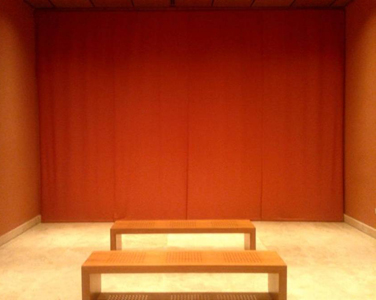Interview by Daniele Balit : About Back to Mono
The title of this work, Back to mono, alludes to a collection of pieces by Phil Spector, a pioneer of sound spatialization effects, as well as to the meaning of the prefix “mono”: one alone. Created for the Sound Corner, the work explores sound space perception and revolves around the idea of reinserting a space into other, imaginary or physical, spaces. Yvan Etienne has captured the ambient sounds of the Sound Corner and entrance hall of the Auditorium and applied a series of rudimentary processes to them, such as feedback and multiple registrations. The outcome is an immersive and condensed texture, a kind of ghost noise which permeates the architecture as a whole and gradually increases as one draws closer to the installation.
Daniele Balit
What is the underlying idea behind the installation?
Yvan Etienne
This work explores the perception of space. We float in a space whose boundaries we ignore and which we constantly attempt to saturate through the definition of illusory territories. With this work I have sought to experiment with this saturation of illusory spaces, and to investigate our omnipresent relation to emptiness.
DB
How did you engage in the process of developing the work from a distance?
YE
The perception of distance, of intervals, lies at the centre of this work. As I could not visit the site but wished to develop a work according to its specific features, I chose to base my composition on elements that intuitively struck me as useful in order to pursue my research: the sound of the chosen site and its name, “Sound Corner”. These two parameters provided “openings” allowing me to explore the notion of distance.
DB
What role does spatial acoustics play?
YE
It is somewhat like the negative of a space, an inverted analogy. Listening to the emptiness of an unknown place through a recording inevitably brings to my mind previous listening experiences. All this reactivated fragments of representations, shapes and contexts. In the recording you can hear an ubiquitous murmur and some faraway noises that suggest a certain volume, a certain place, certain presences. What is perceived, through various resonant bodies (substances, objects, materials), is a kind of latent space.
DB
Is the fact that someone else – namely myself – recorded the sound simply a detail?
YE
Not at all. I regard this as a vector for de-personalization, a distance which removes me from a given “reality” and so enables me to explore my own way of perceiving things. It's a tool, an aleatory extension.
DB
How was the work developed, then?
YE
I concretely envisaged the idea of the Sound Corner as a crossroads of sounds, a junction. The audio recording made from this site has undergone various rudimentary treatments (feedback, re-registration...) and has in a way been projected into a range of fictitious spaces that multiply its nature, as though through a series of filtering operations.
These sounds, combined into a single track and released throughout the site in mono, represent a way for me to evoke certain spaces and pose the question of the nature of space and of its perception. |
